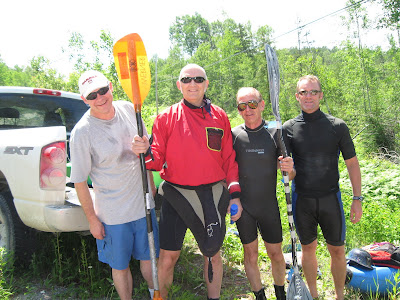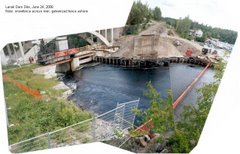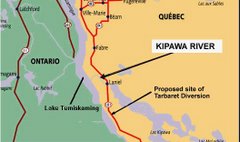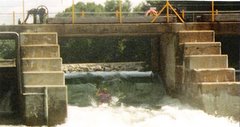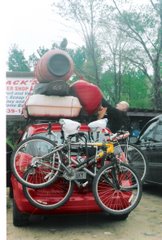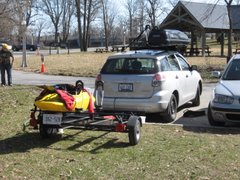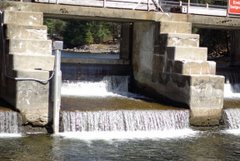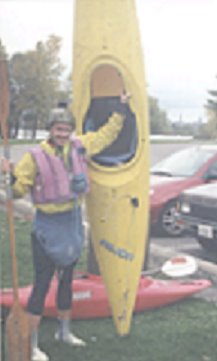How to become an Environmental Activist
How to be an Activist There is no formal school for activists. No university degree qualifies the graduate to practice grassroots organizing. Environmental activists, like many other practitioners of social change, come in all shapes and sizes, from all walks of life, and even from all political parties. And all of us learn from experience. On the other hand, we should be able to benefit from the experience of others. Unfortunately, more often than not, people suddenly find themselves in a situation that requires a certain moral heroism. They had not planned to become activists. Environmental problems themselves create activists. When a toxic landfill threatens the neighbourhood, local lawyers may volunteer to do some legal work, scientists may offer volunteer help and the community of concerned parents suddenly find themselves wondering how to write a press release, circulate petitions, and, even conduct a sit-in in a politician’s office. By the time they are in the thick of a campaign, it is hard to know where to turn for help and advice. The reality of ordinary people picking up the gauntlet and becoming politically active is largely unknown to the as-yet uninitiated public. By the time the small neighbourhood citizens group gets its issue before the public, its members are already being labeled as “environmentalists”. From that point on, their true identity is lost as surely as Clark Kent’s when he emerges as Superman. The media labeling process does society a disservice. It cuts off “activists” and “environmentalists” from “normal” people. The general public, as demonstrated by numerous polls, supports the principles of environmental protection and restoration, but usually they believe it is for some other category of people, called “environmentalists”, to do the work they support. When an environmental group is described as a “special interest” group, there is a blurring between those who protect “special” interests, usually of a financial nature, and those who work on a volunteer basis, usually at personal sacrifice and expense, to pursue a cause in the public good. The reality of activism, for the environment or any other cause, is that democracy is at work. Citizens are exercising democratic rights. Rather than being the exception to the rule, for democracy to thrive, all citizens should be activists. A Few Good Starting Points Recognizing that environmental activism is a democratic right, it is important to have a few good starting points to encourage the neophyte. Refuse to be intimidated. If you are told that a subject is too technical or scientific for you to understand, don’t believe it. Elected politicians make these decisions all the time based on general knowledge and their sense of public opinion. The claim of “expert” versus average concerned citizen is inherently anti- democratic and elitist. You may not be an expert. But you can read and understand what experts have to say. Make a note of good quotes (including the source) of expert views concerned with the environment. Start your own card file of references to unleash if someone tries to suggest you don’t know enough to be involved. Be creative! Every campaign and issue has its own dynamic. Let your creative juices flow. Maybe satire will work for you. Maybe song. Even conventional campaigns can attract more people if you have an optimistic, innovative approach. Don’t take no for an answer. If you want to meet an elected official, call every day. Drop by the office and get to know the staff. Be persistent.The squeaky wheel. Ask lots of questions. Get to the bottom of issues. Do your homework. Use the telephone. It is a great research tool. Ten times better than writing and asking for information is phoning until you find the person who knows the answer and will immediately send you information. In addition to getting what you want, you may have uncovered a good source for future information - and maybe even an ally in the bureaucracy. Be unfailingly polite. Being persistent is not the same thing as being rude. You may be in this for the long haul, so don’t burn any bridges. Leave no stone unturned. Think about who knows who. How can you expand your network? Your allies may come from unexpected places, so do not make assumptions. Ask people for help. When someone in government does something good for the environment, be sure to give public credit and thanks. You can accomplish anything, if you don’t care who gets the credit. Remember that politics is also personal. Watch out for burn- out. You’ll need the support of friends and family. Build love into your campaigns. Some Starting Points In local organizing, one of the first things you’ll probably want to do is form a group. Don’t re-invent the wheel. Look around. Is there an existing group, with goals similar to your own, that would accept your group as a working committee, or affiliated chapter? If you can avoid going through the incorporation process and the charitable number ordeal by joining an existing group (and co-opting them to your issue in the process), why not try? If you are organizing your own group, try not to get bogged down in by-laws. Stick to the essentials. If you want to change a decision at City Council in three months, you won’t have time for Robert’s Rules of Order. In order not to lose momentum, and volunteers, make the meetings fun by including some social activity. Plan a pot luck supper first and then work through the agenda efficiently. Folk singer and environmental activist Pete Seeger organized a very successful campaign to clean up the Hudson River. He advised, “Don’t have meetings that only attract the kind of people who like going to meetings.” Be sure to assign tasks as you make decisions. If someone suggests something new, don’t reject it just because everyone who is heavily involved is already too busy. Say “What a great idea! Will you take that on?” Delegate! Pick achievable goals. Positive reinforcement is important. So deciding to make your goal “achieving world peace” or “ending hunger” will likely result in burn-out and disillusionment. On the other hand, making your goal to get 10,000 names on a petition to do either of the above is do-able and will have a positive reinforcing impact - you’ll gain strength and enthusiasm for the next goal. How to get your message in the news media It is a fact of life that environmental groups don’t have money. Some projects may qualify for government grants, but they are usually the “safe” kind. Planting trees. Picking up litter. While such projects are undoubtedly worthwhile, they are not going to change the world. Trying to reduce dependency on environmentally damaging and non-sustainable energy sources (like fossil fuels, large scale hydro and nuclear power) fundamentally challenges the status quo. So does trying to end the use of toxic pesticides for cosmetic purposes. If you are working on issues like these, it is hard to obtain the kind of money it takes to gain public (and political) attention through advertising. The mainstay of your information and awareness campaign is going to be the news media. Hence, the environmental movement and the news media have an awkward and symbiotic relationship: they need us for stories, and the environmental movement certainly needs them. But environmentalists get frustrated with the superficiality of news coverage of issues that threaten planetary survival, and the news media get sick of hearing what they often regard as predictable whining from the greens. So how can you, with little or no media experience, be expected to break through to reasonably accurate coverage of your concerns? First, you should understand a few things about the news media.. Noam Chomsky’s analysis (“Manufacturing Consent”) notwithstanding, you can get your issue in the public eye. It helps if you are able to see the story from the reporter’s point of view. There are very few newspapers or electronic networks with a full time environmental reporter. You are trying to get a reporter, who has to cover everything from tax hikes to crime on the street, interested in your story. There are no Woodwards and Bernsteins. Calling and telling them there’s a big story out there if they do some really good investigative reporting will get your message consigned to the waste basket, (or, in an environmentally aware newsroom, the recycling bin.) If you want a reporter to cover your story, you have to do all their work for them. Think it through. Where’s the angle? “A local group of environmentalists are organizing to save the environment” is hardly an earth shattering story. Remember the old adage, “Dog bites man” is not a story. “Man bites dog” is. Tie your issue to other political events, like elections or previous campaign promises. What are the financial issues? Is taxpayers’ money being wasted? Are jobs being lost? Are the environmental alternatives better for the economy? (They usually are.) Make it interesting to someone who doesn’t give a hydro-electric dam. Fill in the “5 W’s” : Who, What, When, Where and Why. Make sure all your facts are absolutely accurate. Write your own press release. It should read like a news story, not like your group’s manifesto. Put in quotes from group representatives. Be sure to include phone numbers so that reporters can call you to get more details and re-work your press release into their own story. SAMPLE PRESS RELEASE PRESS RELEASE (Your logo appears here) Group’s mailing address Headline in Boldface Appears at Top DATE: Put the date on which you want the story to be released, or put the words "For immediate release:" at the beginning of your release. TEXT: The first sentence should be clear, factual and grab the attention of the reader. It should tell the press what the story is about. TEXT EXAMPLE: (City): Citizens Organized to Save Wetlands today announced the results of their audit of the costs of the proposed Department of Boondoggles development. “By our calculations, reviewed by the firm of Somebody Credible Ltd., the Department of Boondoggles will be increasing the provincial deficit by $300 million by choosing this environmentally sensitive site, instead of merely recycling their existing building,” said group chair, J. Q. Public. Citizens Organized to Save Wetlands are considering legal action if their current petition campaign is unsuccessful in persuading the Department to re-consider its plans. They are also planning a demonstration in front of Department headquarters to take place next Wednesday, the xth of xx, at 12 noon. “We are confident that good sense will prevail,” said group researcher I. M. Green, “With the provincial election in the offing, and so many environmentally concerned statements coming from the Premier’s Office, we simply cannot believe that this deliberately wrong-headed policy will prevail. - 30 - (It is a convention of news releases that they end with “- 30 -”. It tells reporters that the text has ended.) Contact information: (Don’t forget to include the name and phone number where people quoted in the release can be reached for comment.) Send your release to ensure it reaches the media before or on your release date. If you are far from a media centre, you can fax your release, or phone it in to the closest office of the Canadian Press (CP). CP is a wire service. If it puts your story on their service, it will automatically reach television, radio and newspaper newsrooms. It is then the decision of the news director in each outlet whether to use your story. I used to send releases from a town of 45 people in Cape Breton Island down to CP in Halifax, phoning it in right before I went to sleep to get low phone rates. I can remember how astonishing it was to wake up in the morning and hear my release on the radio. Beyond press releases, you may want to hold a press conference. Don’t do it unless you have a really good story, or can bring in an acknowledged expert who won’t be available as a matter of course. Hold press conferences somewhere familiar to the media. Make it convenient. Try to avoid having to spend money to rent space. Is there a good community centre close to the downtown? Can you get the help of someone in City Council to use City Hall or the Regional Government Centre? -------------------------------------------------------------------------------- A SHOPPING LIST OF CAMPAIGN TACTICS The following are tried and true. It is a good idea to try something fairly straightforward initially, with minimum risk of failure. 1) Letter writing campaigns Politicians really do pay attention to their mail! Especially the volume of mail. As letters mount up on an issue, it will achieve greater importance. At the national level, one letter is considered to represent thousands of people’s opinions. The ratio declines as you move down the government hierarchy, but at the municipal level, fewer people write, so the letters still have clout. Your letter does not have to be typed. Handwriting is fine. So is word processing. The key is that your letter is original and not recognizable as a pre-printed message. ALWAYS SIGN YOUR LETTERS. Include your address for their response. Your letter does not have to be technical. You do not have to know everything about an issue to write and express your opinion. It does have to be clear. State explicitly what you want the politician to do. Include a specific question requesting his or her response. If the response misses the point or is inadequate, write again. Remember, at the level of federal and provincial ministers, a staff person in the bureaucracy writes the response. The minister may not even see your letter. Why persist? Because as the number of letters add up, the issue is given greater importance. Sometimes you are even able to educate the bureaucracy, or alert the minister to the fact that the staff has him or her signing inaccurate letters. (My brother in Nova Scotia actually called a Minister at home once to say that he didn’t want to attack the Minister in the press over a particularly lame response to a letter. He gave the Minister a chance by asking him if he knew that the letter prepared by his bureaucrats included misleading information. The Minister didn’t know and was grateful for the call.) 2) Letters to the Editor Did you know that the letters section is the most read section of any newspaper? Not only do people in your community read the letters, government officials have clipping services that reprint the ones dealing with their area. The federal minister of the environment sees clippings from coast to coast, including letters to the editor, every day. Letters should be short, direct and well written. Of course, they should be accurate and educate readers about your issue. Watch for opportunities to respond to articles that have been in the paper. 3) Call-in radio & tv shows There are opportunities for free access to the airwaves. Listen to a show a few times before you call in. Get a sense of the host so you won’t be surprised if they disagree with you. It is easy, anonymous and can get your message to lots of people. 4) Petition campaigns The U.S. Declaration of Independence was sort-of a petition. Less than fifty people signed it and the rest is history. Petitions are an excellent first step for new groups. They are tools for public education. The preamble should set out clearly what the issue is and all the reasons for your concern. (Remember the “WHEREAS’s!) They also force you to know clearly what you want from the government. If you want the municipal council to ban pesticide spraying on all public and private lands, say so. If you want them to maintain a handful of pesticide-free parks, say so. But don’t leave a petition hanging with just a general, “we are against pesticides” statement. Petitions can be circulated door to door, left with sympathetic local merchants, or you can set up a table in the local mall (although this usually has to be arranged fairly far ahead.) If you are trying to solicit support in a public venue like a mall, don’t be shy! Smile and ask people as they come by if they are interested in the environment. If they avert their eyes and walk away, so be it. Leave them alone and KEEP SMILING! Set a goal. Know when you are done and make a big deal out of presenting the petition. Get a sympathetic politician to accept it from you and alert the media. 5) Fundraising Wait a minute. Isn’t this a shopping list of campaign tools? Well, yes. But good grassroots fundraising is not only a way of raising money, it is a way of raising awareness. (And it also deals with that unspoken question of the uninitiated public, “where do those people get their donations?”) Grassroots fundraising should involve lots of people as volunteers. Try to get local donations of supplies, advertising, prizes or whatever from local merchants (and of course give them public credit and thanks). What kinds of things are grassroots fundraisers? Here’s a sample list. But it’s not exhaustive. You can build on these ideas, but better still, come up with your own. Potluck suppers with an entrance fee. Fun. Great food. Cheap and you’ll have something for the campaign pot when the dishes are done. Bake sales. You can get lots of people involved. Hold it at the local mall, or after church. Raffles. Go for donated prizes or make your own. In Cape Breton we raised thousands of dollars with quilt raffles to stop the spraying of 2,4-D and 2,4,5-T. Hold a community fair! Have clowns. Kids’ events. Sell baked goods, homegrown organic veggies, preserves, handcrafts. Include an auction. Ask a local bar if you can have an evening of entertainment for a cause. This will appeal to lots of young people. Musicians are notoriously generous in their support of environmental causes. God bless them. Hold an auction. It could be an art auction. Or hold a flea market of odd junk items. Donate services — a deluxe brunch in someone’s home, or catered to your place, a sailboat outing, babysitting, carpentry, barter for cash for the cause! Hold a massive yard sale. Recycle all your stuff and raise funds. Sometimes in our community environmental struggles in Cape Breton, I was convinced we just kept selling our old plates and hand-me-downs to each other. But it worked. Hold a church supper. Church halls can be rented for not too much, and they are perfect. Big kitchens, well equipped for a crowd and they feel great for community events. Order t-shirts or mugs with your message. Sell them at all your events. You can order great posters from a lot of environmental groups, as well as calendars, t-shirts, postcards and other merchandise. Contact Sierra Club or Western Canada Wilderness for great items. -------------------------------------------------------------------------------- How to lobby Whether you’re working to change a policy at City Hall or the federal cabinet, you’ll probably want to sit down and meet with a few of the people who’ll be making that decision. The approach is the same, regardless of how elevated the politician or bureaucrat is. (and, yes, you do have to lobby bureaucrats). As recommended in the “Starting Points” at the beginning of this document: Be unfailingly polite, persistent, network, leave no stone unturned. Experienced fundraisers say you can reach anyone in the world with only two phone calls. Considering that a radio station in Montreal got through to the Queen of England, who can doubt this is true?! So remember, you may not know the Minister or Mayor now, but there is no reason you can’t get to know them. Don’t be intimidated. Once you have a thorough knowledge of your issue and have done your homework, there’s no reason you can’t go to meet key people and put forward your case in person. Preparing for the meeting It is an excellent idea to reduce your key points to a one-page document you can leave with the decision-maker. It’s always easier to write a long document than a short concise one, but the effort to boil down your case is well worth it. Busy people (and the more powerful they are, the busier they are) will never read more than a page. Think through ahead of time what it is you want the decision-maker to do. I know of environmentalists who’ve gone to see very powerful politicians, laid out their case, and prepared for questions on the merits of their argument, only to be completely unprepared for the person agreeing with them and asking the obvious question: “What do you want me to do about this?” If the person you’re seeing is in Cabinet, for example, but not the Minister who actually makes the decision, think through exactly what you want. What is the most strategic thing this person can do to advance your case? Is it to speak quietly to someone, to issue a public statement or to introduce you to someone else so you can explain the issue to them? Your one page note should end with a very specific request. You should also prepare for the personal side of the visit. If nothing else, you will have advanced your cause if the politician is left with a favourable impression - if you’ve started the process of building a relationship. So, do a little research about the person you’ll be meeting. When was she elected to government? Where did he go to university? If hunting and fishing are known to be favourite past-times, build on that to create environmental awareness. Ideally, you’ll find you know someone in common, or that you’ve gone to the same school, or that she was in school with your dad. Be especially sure to research any previous good deeds for the environment. The best way to start any meeting is to thank the politician for something they accomplished in the past. Even if it was twenty years ago, they’ll feel great to know someone still remembers. And you’ll have them remembering that these issues are (or were) important to them. Don’t ignore the small talk. It may be the best part of your meeting. If you are going as part of a group, think through how many of you should go. As a general rule, it is a poor idea to have more than three or four people go in to meet with politicians. It is increasingly intimidating for them, and unwieldy as the meeting size grows. Be strategic. If possible do not go to a meeting in a group larger than two or three. Be sure to tell the scheduling person you are dealing with the size of your delegation and the names of the people coming with you. Plan ahead who will cover which points. The Meeting Dressing for the meeting is unfortunately something that should be mentioned. Although there is no question that your value as an individual has nothing to do with how you look, you’ll be more likely to reach a decision-maker if you are dressed in a way to which they are accustomed. Business suits go over better than jeans and sandals. I only wear make-up for media and lobbying. I call it war paint. (As my sister-in-law says, “A girl’s gotta do, what a girl’s gotta do.”) If you haven’t had time to research this person’s background, you can still look for clues around their office. Diplomas, photos, plaques. Find some way to have a more personal chat at some point in the meeting. Most people love talking about themselves. It puts them at ease. A nervous and impatient person is not easy to influence. And, of course, you may find something that creates some common denominators in your lives. Many people have a one dimensional image of environmentalists. Somehow they don’t think we have real lives, children, jobs, other interests. Breaking down the stereotypes is a significant part of your task. Once you’ve had a bit of small talk, move quickly into the main agenda. Be courteous. Show an awareness that this person is probably very busy. Ask at the outset how much time the person has until their next appointment, bearing in mind that meetings often start late and keep backing up. Do not take up more time than has been allotted. Present your case clearly and calmly. Give the decision maker your one-page note so they can follow along. Provide any more detailed papers you would like to leave as well. If your issue has a visual element, bring photos. Be sure to ask if the person has any questions. If you don’t know the answer to something, don’t bluff! Make a note and promise to get the information. And, then, remember to get it and send it to the decision- maker quickly, the next day if possible. Remember to ask clearly for what you want. And thank them, first, verbally, and then after with a thank you letter which reminds them graciously of any follow-up they offered to do. -------------------------------------------------------------------------------- Politicians are still just people. They are mostly honest, mostly over-worked, and often wrong. If you can help them to do the right thing, why not try? -------------------------------------------------------------------------------- The Sierra Club of Canada is dedicated to developing a diverse, well-trained grassroots network working to protect the integrity of our global ecosystems. In pursuit of this goal, the Sierra Club of Canada holds Activist Training Workshops. If you or your local group would like to attend or arrange such a workshop, contact the National Office. For more information please contact: Sierra Club of Canada National Office Tel: (613) 241-4611 Fax: (613) 241-2292 e-mail: info@sierraclub.ca web:














